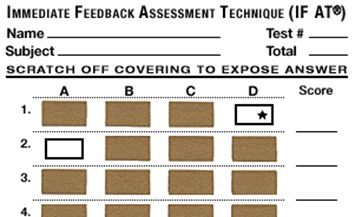Team-Based Learning
The course will use team-based learning (TBL). This is a learning method to ensure active learning in small teams. It will make this course intensive, but also the source of much fun. By the end of the semester, most students prefer TBL to traditional lectures.
Some features of team-based and active learning:
- You will be part of a team of 5 to 7 students that stays constant during the semester.
- You will receive a preparation guide that will help you to prepare for a lecture, for instance by reading a book chapter, doing a specific exercise or watching a video.
- We will do several readiness assurance tests (RATs). These are multiple-choice tests that are easy to solve when you are reasonably prepared.
- The team will help during the RAT, and this also counts towards the final grade.
How TBL Works
The course consists of separate units, roughly one for each week. Each week will be organized in a very similar way:
- You need to prepare for the unit.
- At class time we start with a test about the reading material, a so-called RAT.
- After the RAT, you get special activities that you do together in your team. Depending on the activities, there are different ways of handing in the results.
Phase 1: Preparation
The preparation happens individually. Sometimes it is one or two chapters of a book, special reading material developed for this course or some videos. This gives you the opportunity to study at your own pace and get familiar with a new topic. Of course it will vary how much time each student will spend on the preparation material, and it also depends on the unit, but roughly 2 hours is a good guideline, sometimes more and sometimes less.
- Have a look at the schedule. It shows on which days we have RATs, with a link to the corresponding preparation material.
Phase 2: Individual RAT
A RAT is a multiple-choice test with 10 questions that have 4 answer alternatives. You get 20 minutes to answer the test individually. The questions are not particularly difficult, and directly related to the preparation material. Some questions may still feel a bit tricky, since we want you to select the best answer.
- The scores of your RAT do not count towards your final grade.
- This means you can completely focus on understanding the answers and getting feedback on your state of preparedness for the unit.
- It is mandatory to submit all RATs. If you are sick on a Monday and cannot participate, you can do the RAT later. (In this case, you only do the individual RAT, not the team-RAT explained next.)
Phase 3: Team RAT
After the first 20 minutes with the individual RAT, you get the same test again, but this time you solve it in your team. At the beginning, get the team-RAT, and find the assigned place in the auditorium for your team. Together with your team-RAT you receive an attached scratch card. You need to discuss with your team members and agree on a common answer. Once you agree on an answer, you scratch the corresponding field on the scratch card open. If the answer was correct, you'll see a little star in it. In this case, proceed with the next question. If you don't see a star, find the next answer alternative, until you find it.

For best learning, make sure of the following:
- Everybody should contribute and be heard in the discussion.
- Solve the question one by one, and scratch immediately after you have discussed a question. (That means, don't scratch all questions at once at the end.)
- Don't vote on the answer alternative, discuss until you agree on which one is best.
Phase 4: Team Activities
After the team-RAT we continue with the team activities for this learning unit. We will introduce the activities and clarify any questions about the task, the expectations, and how you deliver your results.
After the class time you can either continue working in your team or schedule a time when all are available. The team activities are timed to fit in an 2-hour block. You finish each team activity with a delivery and also a team reflection. Depending on the type of activity and delivery, you'll get some feedback on it during the next week.
Videos about TBL
Have a look how TBL works at other universities.
Team-Based Learning at Duke University
Team-Based Learning at Bradford
Sheri Wall on TBL
On Forming Teams
In TBL, teams are assigned by the instructor. Let's hear the description from Michael Sweet why this is a good idea: